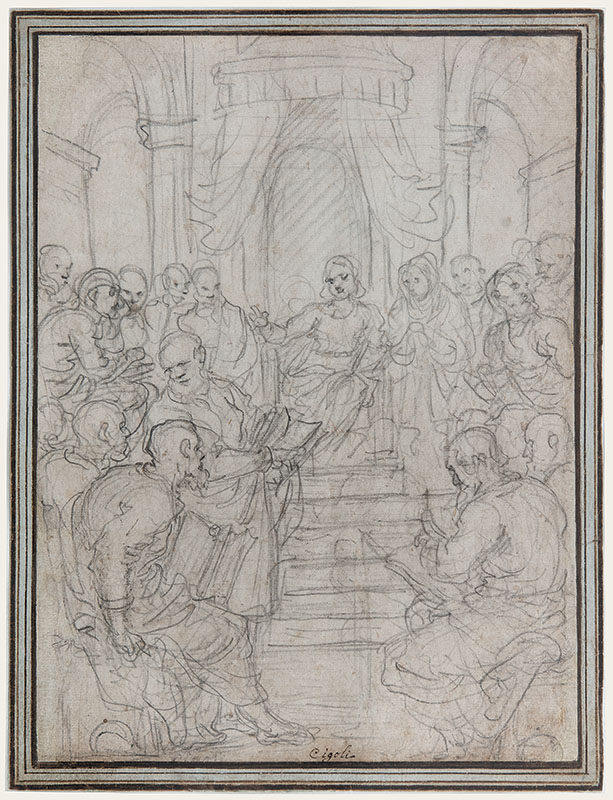Domenico known as il Passignano
Passignano 1556 - Florence 1638
290 x 216 mm
Inscription: Cigoli at the lower center, brown ink.
Provenance: Ignazio Hugford (Florence 1703-1778), his mount in green and gray
Our drawing is related to the large painting by Passignano Jesus among the Doctors, located on an altar in the Church of San Francesco, Borgo San Sepolcro. According to Joan LNissman the work must be dated around 1595. Typical of the Florentine approach to painting was the development of a composition and the figures first with elaborate drawings. Our drawing is the earliest known preparatory study for the painting, and shows a vast temple with two arches, a raised podium and many robed figures in active discussion. Mary and Joseph stay at the upper right and, framed by the niche and the draped canopy, the seated Jesus is discoursing with the doctors. The drawing is a prelude to the more orchestrated groups of figures, simplified setting, and the standing figure of Jesus in the black chalk drawing in the Uffizi, no. 9169 F recto, and in the painting. The present drawing is a significant new discovery and addition to the history of this painting.
Passignano ranks, for his monumental, dramatic narrative painting style, with Lodovico Cigoli, Jacopo Empoli and the slightly older Santi di Tito as a leader in late sixteenth-century Florence. It was they who, influenced by Counter Reformation concerns for accuracy and piety, moved from Mannerist conventions to a new realism, clarity, and expressive power that initiated the Baroque in Florentine art.
Price on application
Information on the master
Around the age of nine Passignano was sent to Florence, where, according to Baldinucci, he studied first with Girolamo Macchietti and then with Giovan Battista Naldini. His most important teacher, however, was Federico Zuccaro, with whom Passignano worked as an assistant in the completion of Vasari's frescoes for the Florentine Duomo. He accompanied Zuccaro to Rome in 1579 and to Venice in 1581, where he was much influenced by the Venetian painters, Titian, Tintoretto and Veronese. He was back in Florence by the end of the 1580s, painting his early masterpiece, the frescoes in the Cappella di S. Antonino in S. Marco. Passignano was much active in Florence and Tuscany for the rest of the century. In 1602 he was back in Rome where he was called to work in St. Peter’s and where he absorbed something of the new realistic style of Caravaggio and the Carracci. With Cigoli, a competitor, he was one of the most important Florentine painters of the turn of the century, practicing a powerful, Proto-Baroque style, influenced by the Venetians and then by the Roman works of Caravaggio and the Carracci. His drawings show a similar indebtedness to Venetian models but, like most Florentine draughtsmen of his generation, he made a constant practice of drawing from life.
